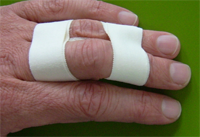Athletic taping
Athletic taping is a common practice in sports medicine and physical therapy that involves the application of adhesive tape to provide support and stability to muscles and joints during physical activity. This technique is used to prevent injuries, reduce pain, and enhance performance in athletes of all levels.

History[edit]
The practice of athletic taping dates back to ancient times when athletes would use strips of cloth to wrap around their limbs for support. Over the years, the technique has evolved with the development of specialized tapes and improved application methods.
Benefits[edit]
Athletic taping offers several benefits, including:
- Support: Taping can help support weak or injured muscles and joints, reducing the risk of further injury.
- Stability: Taping provides stability to joints, allowing athletes to move more efficiently and with less risk of injury.
- Pain relief: Taping can help alleviate pain by reducing stress on injured tissues and promoting proper alignment.
- Performance enhancement: Taping can improve proprioception and muscle activation, leading to enhanced performance during physical activity.
Techniques[edit]
There are various techniques for athletic taping, each serving a specific purpose:
- Ankle taping: Used to support and stabilize the ankle joint, especially in sports that involve jumping and cutting movements.
- Knee taping: Helps support the knee joint and prevent excessive movement during activities that put stress on the knee.
- Shoulder taping: Provides support to the shoulder joint, particularly in overhead sports like baseball and volleyball.
- Wrist taping: Supports the wrist and thumb joints, commonly used in sports that involve gripping and throwing.
Considerations[edit]
While athletic taping can be beneficial, it is important to consider the following:
- Proper technique: Taping should be done by a trained professional to ensure effectiveness and prevent skin irritation.
- Skin sensitivity: Some individuals may be allergic to the adhesive in sports tape, so it is essential to test for any reactions before application.
- Regular monitoring: Taping should be regularly checked and adjusted as needed to maintain its effectiveness during physical activity.
Ad. Transform your life with W8MD's Budget GLP-1 injections from $75


W8MD offers a medical weight loss program to lose weight in Philadelphia. Our physician-supervised medical weight loss provides:
- Weight loss injections in NYC (generic and brand names):
- Zepbound / Mounjaro, Wegovy / Ozempic, Saxenda
- Most insurances accepted or discounted self-pay rates. We will obtain insurance prior authorizations if needed.
- Generic GLP1 weight loss injections from $75 for the starting dose.
- Also offer prescription weight loss medications including Phentermine, Qsymia, Diethylpropion, Contrave etc.
NYC weight loss doctor appointmentsNYC weight loss doctor appointments
Start your NYC weight loss journey today at our NYC medical weight loss and Philadelphia medical weight loss clinics.
- Call 718-946-5500 to lose weight in NYC or for medical weight loss in Philadelphia 215-676-2334.
- Tags:NYC medical weight loss, Philadelphia lose weight Zepbound NYC, Budget GLP1 weight loss injections, Wegovy Philadelphia, Wegovy NYC, Philadelphia medical weight loss, Brookly weight loss and Wegovy NYC
|
WikiMD's Wellness Encyclopedia |
| Let Food Be Thy Medicine Medicine Thy Food - Hippocrates |
Medical Disclaimer: WikiMD is not a substitute for professional medical advice. The information on WikiMD is provided as an information resource only, may be incorrect, outdated or misleading, and is not to be used or relied on for any diagnostic or treatment purposes. Please consult your health care provider before making any healthcare decisions or for guidance about a specific medical condition. WikiMD expressly disclaims responsibility, and shall have no liability, for any damages, loss, injury, or liability whatsoever suffered as a result of your reliance on the information contained in this site. By visiting this site you agree to the foregoing terms and conditions, which may from time to time be changed or supplemented by WikiMD. If you do not agree to the foregoing terms and conditions, you should not enter or use this site. See full disclaimer.
Credits:Most images are courtesy of Wikimedia commons, and templates, categories Wikipedia, licensed under CC BY SA or similar.
Translate this page: - East Asian
中文,
日本,
한국어,
South Asian
हिन्दी,
தமிழ்,
తెలుగు,
Urdu,
ಕನ್ನಡ,
Southeast Asian
Indonesian,
Vietnamese,
Thai,
မြန်မာဘာသာ,
বাংলা
European
español,
Deutsch,
français,
Greek,
português do Brasil,
polski,
română,
русский,
Nederlands,
norsk,
svenska,
suomi,
Italian
Middle Eastern & African
عربى,
Turkish,
Persian,
Hebrew,
Afrikaans,
isiZulu,
Kiswahili,
Other
Bulgarian,
Hungarian,
Czech,
Swedish,
മലയാളം,
मराठी,
ਪੰਜਾਬੀ,
ગુજરાતી,
Portuguese,
Ukrainian
